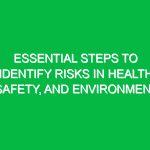Welcome, Team!
Today, we’re gathered for an essential Toolbox Talk focused on a topic that is often overlooked but crucial for our health and Safety: Lyme Disease. As many of you work outdoors or in environments where ticks may thrive, understanding Lyme Disease risks is vital for ensuring your well-being and that of your fellow coworkers. By the end of this talk, you will have a comprehensive understanding of Lyme Disease, its symptoms, prevention strategies, and how to maintain a safe working Environment.
What is Lyme Disease?
Lyme Disease is an infectious disease caused by the bite of infected black-legged ticks, commonly known as deer ticks. The bacteria responsible for Lyme Disease is called Borrelia burgdorferi. It is important for all of us to understand how this disease affects our health, especially when spending time outdoors. When ticks attach to our skin and feed on our blood, they can transmit the bacteria, leading to serious health complications if left untreated.
The Importance of Recognizing Lyme Disease
Preventing Lyme Disease is not just about individual health; it’s about creating a safer workplace for everyone. In our line of work, we may find ourselves in areas where ticks are prevalent. Therefore, being informed about Lyme Disease will empower you to take the necessary Precautions and act swiftly if you suspect an infection. Let’s dig deeper into the symptoms, transmission, and Prevention strategies.
Symptoms of Lyme Disease
Recognizing the symptoms of Lyme Disease is key for early intervention. Some common symptoms include:
- Early Symptoms: These usually appear within 3 to 30 days after a tick bite and may include fever, chills, fatigue, body aches, and swollen lymph nodes.
- Erythema Migrans: This is a distinctive rash that occurs in about 70-80% of infected individuals. It may appear as a bull’s-eye pattern around the bite site.
- Late Symptoms: If untreated, Lyme Disease can lead to more severe symptoms such as arthritis, neurological issues, and heart problems.
Transmission of Lyme Disease
Understanding how Lyme Disease is transmitted is crucial for prevention. The main vector for Lyme Disease is the black-legged tick. These ticks often inhabit grassy and wooded areas, particularly in the spring and summer months. Here’s how the transmission process typically occurs:
- A tick attaches to a host (e.g., a deer or human) to feed on blood.
- If the tick is infected, the bacteria can enter the host’s bloodstream.
- Symptoms emerge within days or weeks, prompting the need for medical attention.
Identifying Lyme Disease Risks in the Workplace
As we work outdoors or in nature-related settings, it’s essential to be aware of the risks associated with Lyme Disease. Areas that are particularly risky include:
- Wooded environments with leaf litter
- Brushy or grassy areas
- Near animal habitats, especially those of deer or rodents
Being conscious of these environments can help us take preventive measures effectively.
Prevention Strategies for Lyme Disease
Now that we understand the risks, let’s talk about how to prevent Lyme Disease at work. Here are some practical strategies:
Personal Protective Equipment (PPE)
Wearing appropriate clothing is one of the simplest yet most effective ways to prevent tick bites. Here are some tips:
- Wear long-sleeved shirts and long pants tucked into socks.
- Choose light-colored clothing, making it easier to spot ticks.
- Use insect repellent that contains DEET on exposed skin and clothing.
Regular Tick Checks
Conducting regular tick checks is crucial, especially after working in high-risk areas. Here’s how to do it:
- Check your body for ticks, paying close attention to hidden areas such as the scalp, behind the ears, armpits, and groin.
- Use a mirror if needed or ask a colleague to help check hard-to-see areas.
- Shower within two hours of being outdoors to wash off any ticks that may be on your skin.
Workplace Practices
In addition to personal Precautions, there are several workplace practices that can mitigate Lyme Disease risks:
- Keep work areas clear of tall grasses and brush to reduce tick habitats.
- Implement a tick management program that includes regular inspections and treatments of the worksite.
- Encourage employees to report any sightings of ticks or potential tick habitats.
What to Do if You’re Bitten by a Tick
If you discover a tick on your body, it’s important to act quickly:
- Remove the tick as soon as possible using tweezers. Grasp the tick as close to the skin’s surface as you can and pull upward with steady, even pressure.
- Clean the bite area and your hands with rubbing alcohol, an iodine scrub, or soap and water.
- Monitor for symptoms such as rash or fever in the following weeks. If any symptoms develop, seek medical attention.
Real-Life Example: A Case Study
Let’s consider a hypothetical scenario to illustrate the importance of these Precautions. Imagine a team member, John, who works in a wooded area. He wears short sleeves and shorts, believing that it’s too hot for long clothing. After a day of work, he notices a tick on his arm but brushes it off. A week later, he develops a rash and flu-like symptoms. After consulting a doctor, he learns he has contracted Lyme Disease due to the tick bite.
This scenario highlights how quickly a situation can escalate. By using protective clothing and being proactive in checking for ticks, John could have potentially avoided this illness. Always remember, prevention is key.
Regulations and Standards Related to Lyme Disease
It’s also important to be aware of Regulations and standards regarding Lyme Disease in our workplace. Organizations like the Occupational Safety and Health Administration (OSHA) emphasize the importance of a safe work environment, which includes protecting employees from tick-borne diseases.
Our company policy also outlines specific practices to minimize exposure to ticks, including providing proper Training and resources for employees. Compliance with these regulations not only keeps us safe but also fulfills our legal obligations as an employer.
Open Discussion
Before we conclude, I want to open the floor for any questions, concerns, or experiences you would like to share. Have any of you encountered ticks in your work environment? What strategies have you found effective in preventing tick bites? Your input is valuable and can help enhance our collective Safety.
Conclusion
In summary, understanding Lyme Disease is essential for everyone, especially those of us who work in outdoor settings. By recognizing the symptoms, implementing effective prevention strategies, and knowing how to respond if bitten, we can significantly reduce the risk of Lyme Disease. Remember, your health and safety are paramount, and we all play a role in maintaining a safe workplace.
Thank you for your attention and commitment to safety. Let’s continue to look out for one another and ensure that we all go home healthy at the end of the day! Stay safe out there!


